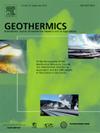基于(X)DLVO和过滤理论的二氧化硅纳米颗粒示踪剂的优化分散稳定性、吸附和沉积性能设计
IF 3.5
2区 工程技术
Q3 ENERGY & FUELS
引用次数: 0
摘要
功能纳米颗粒作为潜在的新型示踪剂出现在地球科学应用中,例如地热储层勘探。本文提出了基于DLVO、扩展DLVO (XDLVO)和滤波理论的优化策略。我们的研究结果表明,纳米颗粒材料应该具有较低的Hamaker常数,这使得金属纳米颗粒不适合。为了确保分散稳定性并尽量减少对通常带负电荷的储层矿物的吸附,纳米颗粒应表现出低于-30 mV的ζ电位。减小纳米颗粒的尺寸增加了与矿物颗粒的扩散驱动碰撞和沉积的概率,而保持颗粒与颗粒的尺寸比小于0.008可以防止颗粒排斥效应。对于纳米颗粒来说,重力对颗粒沉积的影响可以忽略不计,这使得高密度的纳米颗粒示踪剂成为可能。实验结果和XDLVO理论证实了表面修饰的适用性,可以形成一个空间位阻,降低附着效率,同时提高胶体分散的稳定性。温度的影响不能以直接的方式评估,因为它取决于多种因素,这些因素可能会产生相互矛盾的影响。本研究可为设计具有可预测储层输运特性的稳定纳米颗粒示踪剂提供指导。研究表明,选择合适的材料、调整ζ电位或采用有效的表面修饰是提高工程纳米示踪剂地热勘探性能的关键策略。本文章由计算机程序翻译,如有差异,请以英文原文为准。

Design of silica nanoparticle tracers with optimized dispersion stability, sorption and deposition properties based on (X)DLVO and filtration theory
Functional nanoparticles emerged as potential new tracers for geoscientific applications, such as geothermal reservoir exploration. In this study, optimization strategies based on DLVO, extended DLVO (XDLVO) and filtration theory are presented. Our results show that nanoparticle material should have a low Hamaker constant, making metallic nanoparticles unfavorable. To ensure dispersion stability and minimize sorption on commonly negatively charged reservoir minerals, the nanoparticles should exhibit ζ-potentials below -30 mV. Decreasing the size of nanoparticles increases the diffusion-driven collisions with minerals grains and the probability of deposition while keeping the particle-to-grain size ratio below 0.008 prevents size exclusion effects. The impact of gravity on particle deposition is negligible for nanoparticles, making higher-density nanoparticle tracers viable. Experimental findings and XDLVO theory confirm the applicability of surface modifications to form a steric barrier that lowers attachment efficiencies while increasing colloidal dispersion stability. The impact of temperature cannot be assessed in a straightforward manner as it depends on multiple factors that can have contradicting effects. The presented study can serve as a guideline for the design of stable nanoparticle tracers with predictable transport properties in reservoirs. It shows that selecting appropriate materials, adapting ζ-potentials or employing effective surface modifications are key strategies to improve the performance of engineered nanoparticle tracers for geothermal exploration.
求助全文
通过发布文献求助,成功后即可免费获取论文全文。
去求助
来源期刊

Geothermics
工程技术-地球科学综合
CiteScore
7.70
自引率
15.40%
发文量
237
审稿时长
4.5 months
期刊介绍:
Geothermics is an international journal devoted to the research and development of geothermal energy. The International Board of Editors of Geothermics, which comprises specialists in the various aspects of geothermal resources, exploration and development, guarantees the balanced, comprehensive view of scientific and technological developments in this promising energy field.
It promulgates the state of the art and science of geothermal energy, its exploration and exploitation through a regular exchange of information from all parts of the world. The journal publishes articles dealing with the theory, exploration techniques and all aspects of the utilization of geothermal resources. Geothermics serves as the scientific house, or exchange medium, through which the growing community of geothermal specialists can provide and receive information.
 求助内容:
求助内容: 应助结果提醒方式:
应助结果提醒方式:


